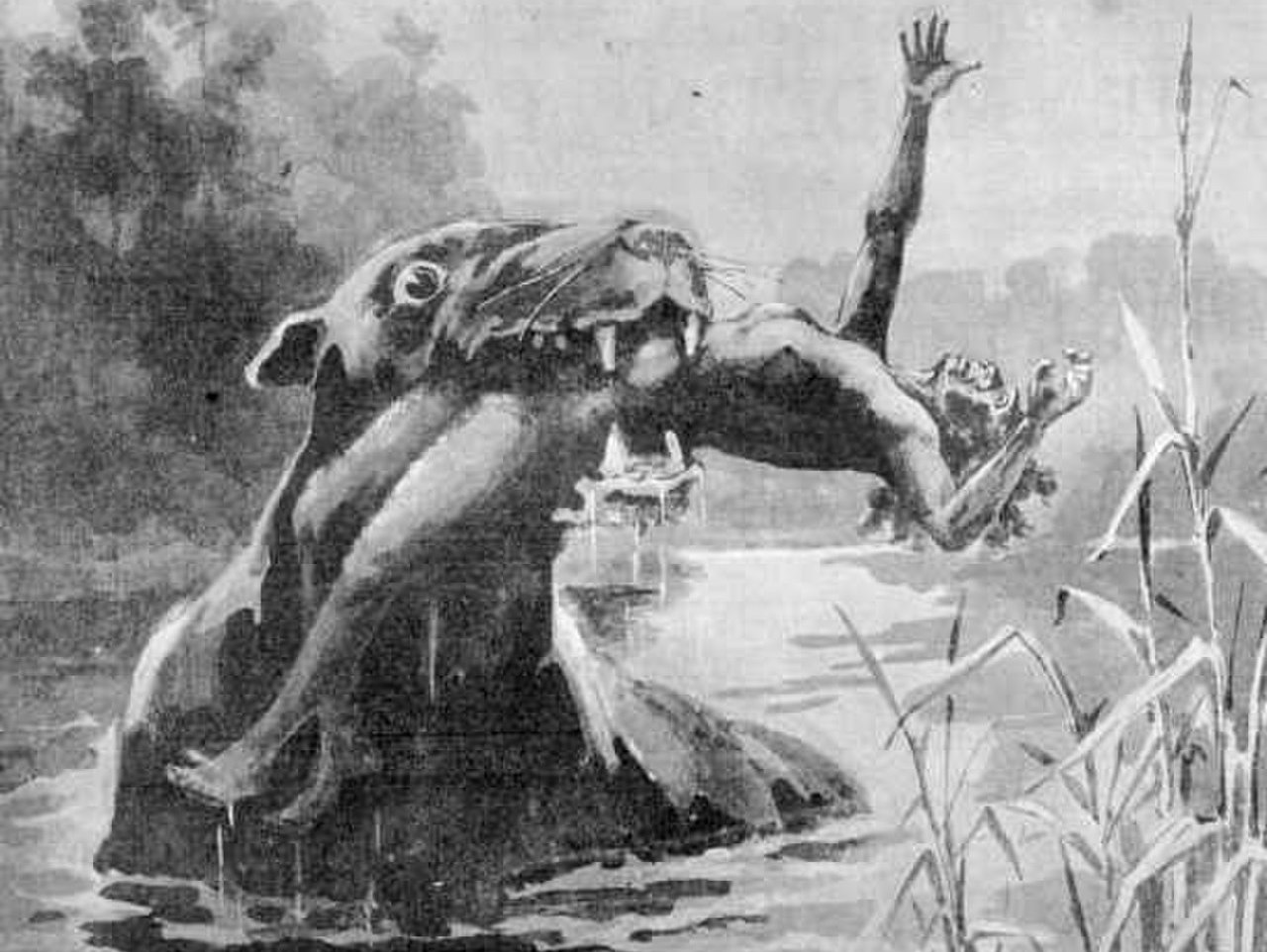
1890 artist’s impression of a bunyip, by J. Macfarlane
The most famous Australian cryptid is the bunyip, an aquatic creature dark as the waters it inhabits. According to Aboriginal tales, they dwell in the mangroves and prey upon the unwary, but no one can agree on what they look like or how they hunt. In some stories, they’re slippery and sinewy, and will snare a stray foot to pull its owner into the depths. In others, they’re as big as bullocks and covered in feathers. Some say they’re as sleek as seals and capture their prey with hypnotism. In all of these tales, however, they bristle with claws and tusks and teeth and have a taste for human flesh.
The first bunyip, according to Aboriginal legend, was a man who broke the laws of the land and was cursed by an envoy of the Rainbow Serpent, the creator god, and transformed into an evil spirit. This malevolent spirit fled to the black waters and took his rage out on humans, devouring any who crossed his path. Some Aboriginal tales also tell of the bunyip turning the women it catches into water spirits, who then serve the bunyip by enticing men into watery graves.
To this day, many Aboriginal Australians fear the bunyip. Elders still teach the children of their tribes to avoid certain waterholes or places along the river. The lesson involves painting the symbols of the bunyip onto the child’s face: two eyes on the forehead, many sharp teeth (represented by lines on the cheeks), and claws on the chin.
Because Aboriginal Australians tend to guard their tribal stories jealously against outsiders, the few bunyip legends that have crossed into the Australian mainstream came from white settlers who managed to coax them out of their Aboriginal hosts. William Buckley, an escaped convict known as the “Wild White Man,” because he lived in an Aboriginal tribe for 32 years around 1800, recounted a story of a tribeswoman who was killed by a bunyip. A family went fishing and caught so many eels that the husband had to make several trips back to the campsite to transport them all. Distracted by this prize, the man left his wife alone at the lagoon and in his absence the bunyip “seized her for food.” For that reason, any lake with an abundance of eels was thought to be suspect and avoided by the tribe. Buckley wanted to find and kill a bunyip but decided against it because he thought such attempts would provoke his hosts into killing him out of fear of the creature.
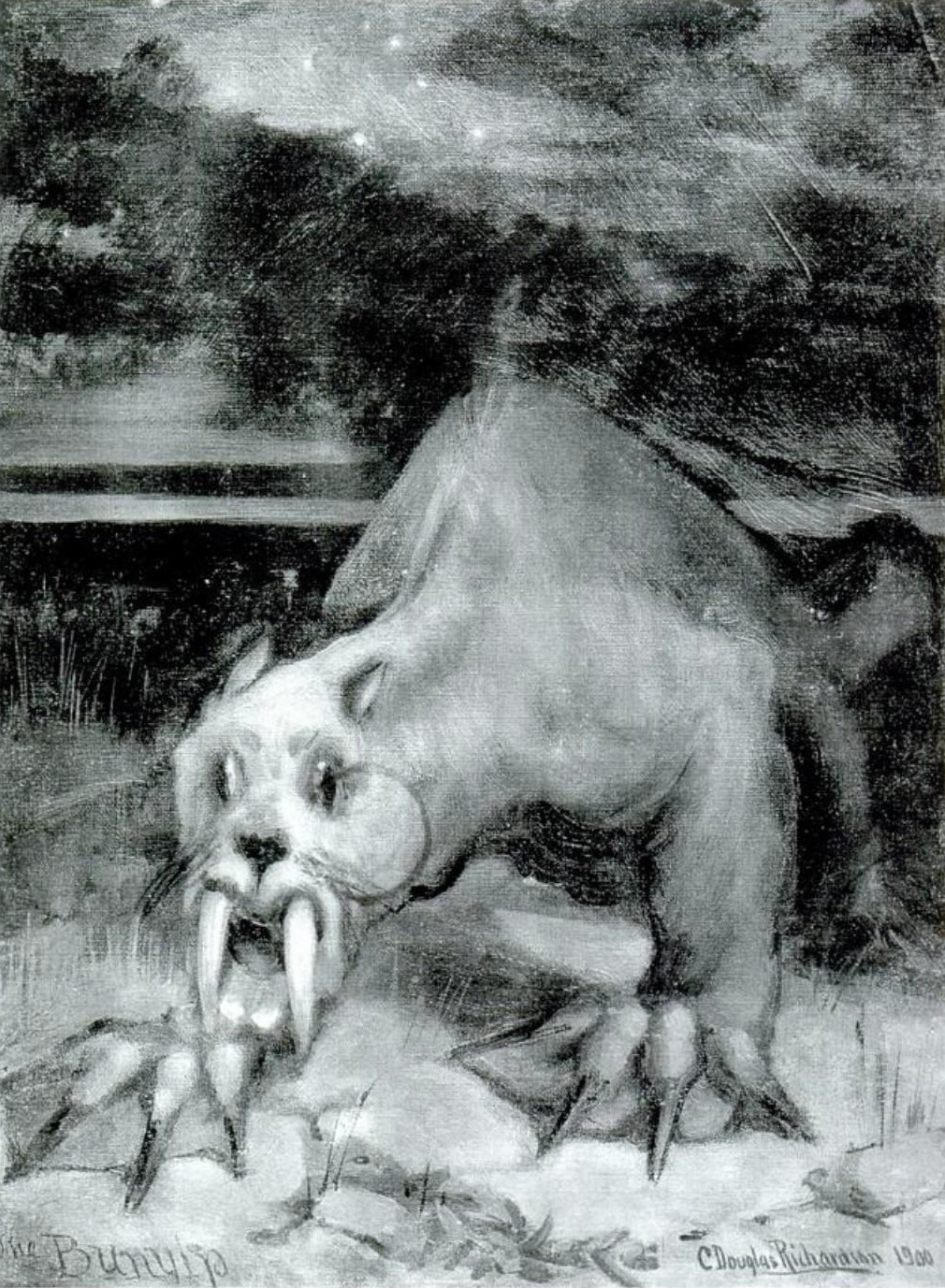
1900 artist’s impression of a bunyip, by Charles Douglas Richardson. No one agrees on what a bunyip looks like.
Similarly, E. Lloyd, known only as “a squatter,” related his conversations with local tribesmen in his memoirs. The Aboriginal people spoke of “a big black fellow, far higher than the ordinary size, [who] walks about during the night, his object being to destroy good black fellows and their children – the latter articles being his favorite diet.” This creature, which Lloyd took to be a bunyip, was as tall as a “big one gum tree” and would tear other trees out by the roots. When Lloyd asked his informant why they couldn’t simply kill the creature, the man said, “oh! Me plenty run away – me too much frightened!”
When the white settlers arrived in Australia in 1788, the Aboriginal peoples repeatedly tried to engender the appropriate level of fear in them, without much success. An article in The Port Phillip Patriot noted that “it is a fact well known to residents and others near the river that the aborigines will not readily venture into the deep and dark pools which remain when its bed is partially dried up.” In 1845, The Geelong Advertiser ran a story about a bone that was “shown to an intelligent black [sic]” who “at once recognized it as belonging to a bunyip.” It went on to compare different accounts from indigenous Australians who “one and all” identified it as a bunyip bone:
The most direct evidence of all was that of Mumbowran, who showed several deep wounds on his breast made by the claws of the animal…They say that the reason why no white man has ever yet seen it, is because it is amphibious, and does not come on land except on extremely hot days when it basks on the bank; but on the slightest noise or whisper they roll gently over into the water, scarcely creating a ripple.
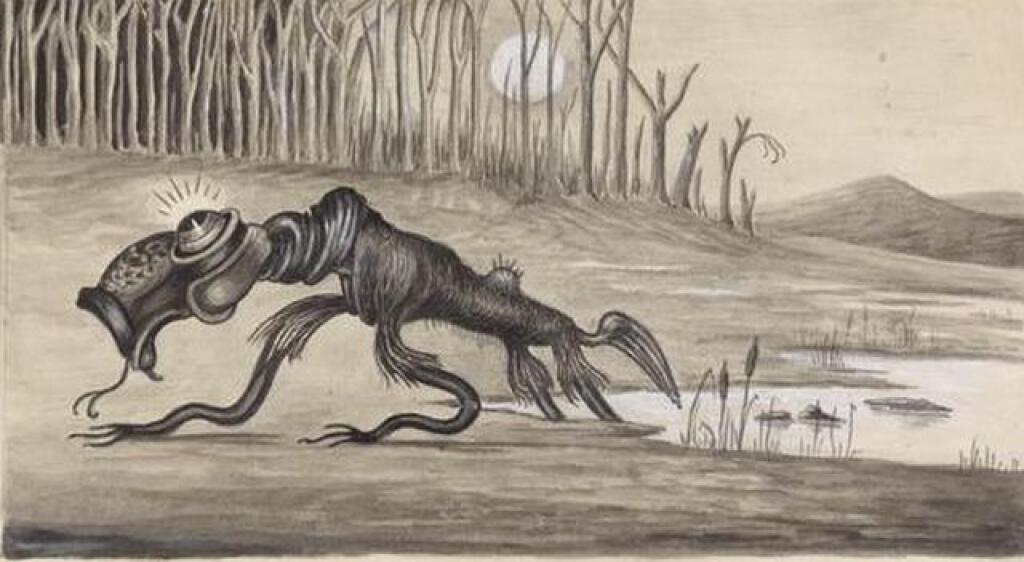
1935 artist’s impression of a bunyip, by Gerald Markham Lewis. Seriously, no one agrees on what it looks like.
Soon after, eye-witness accounts of the bunyip started popping up in Australian newspapers. One man reported seeing “an aquatic beast, as big as a calf” that “roared” and “bellowed” at night. Another reported seeing a “large beast” that sent lake water splashing 10-12 feet high as it “dashed towards the rushes.” One account was so detailed that it described the bunyip right down to the toes: three on each webbed foot. Though its description remained a strange amalgamation of unlikely features, tied together only by habitat, the creature’s existence became widely accepted. A bunyip skull was even exhibited in Sydney Museum in 1847.
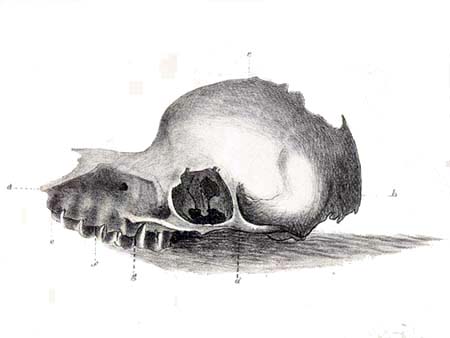
Illustration of the purported bunyip skull
Still, nobody had yet found a live specimen, or even a corpse with some meaty flesh. After a while, the settlers began to doubt the bunyip’s existence. They started offering new theories about the creature: it was a freshwater seal, a fabrication of “some singular aberration of the mind,” an extinct species of megafauna that remained alive only in the indigenous psyche, or simply a “creation of the blackfellows’ terror.”
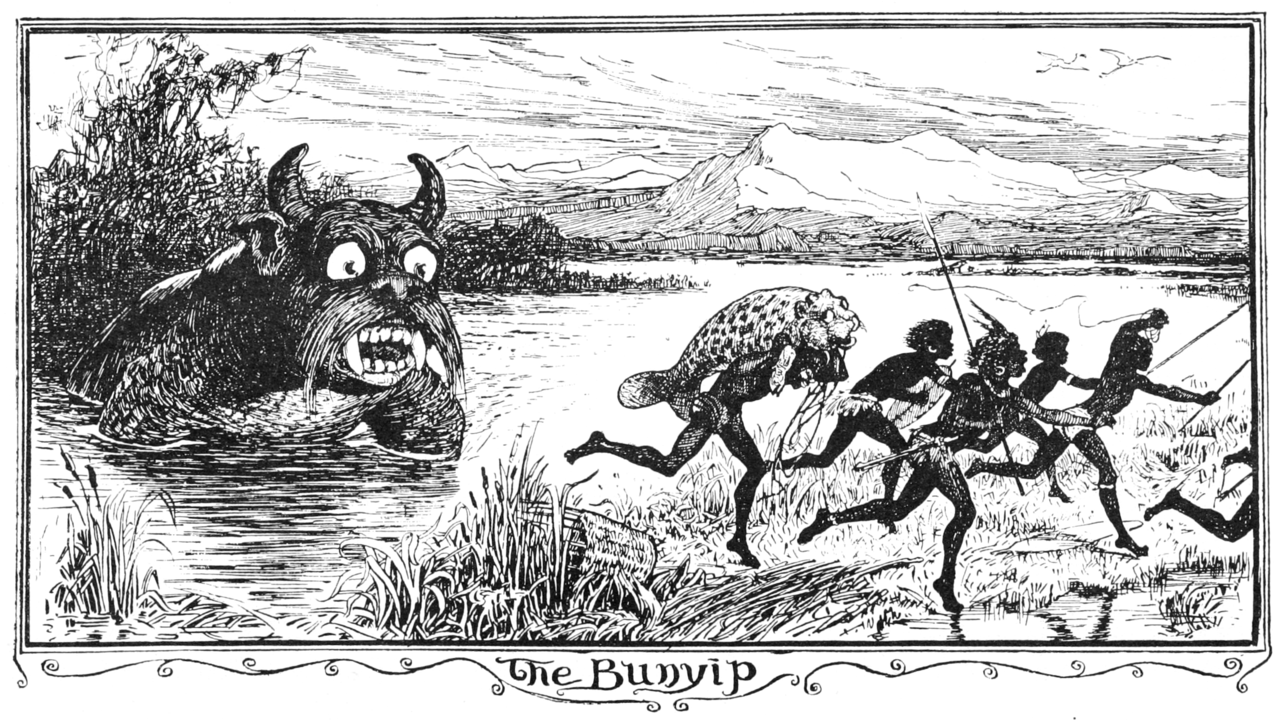
1904 artist’s impression of a bunyip, by H. J. Ford
Slowly, the bunyip morphed into a kind of bogeyman for the settlers. Theatres ran plays called “Desperate Encounter with the Monster Bunyip!” and “The Demon King and the Bunyip Fiend!” When novelist Rosa Praed published her short story, “The Bunyip,” in 1891, she claimed that “everyone who has lived in Australia has heard of the bunyip. It is the one respectable flesh-curdling horror of which Australia can boast.”
Since then, the bunyip has delighted and terrified white Australians. The poem, “The Bunyip and the Whistling Kettle” by John Manifold, was first published in 1946 and tells the story of a “sacrilegious camper” who “scattered papers, cans and bottles and parked his nasty little car” beside a “Bunyip haunted creek.” It goes on:
He donned a bathing-suit in shelter,
And left the firelight’s friendly ring.
He felt the water kiss and tingle.
He heard the silence — none too soon!
A ripple broke against the shingle,
And dark with blood it met the moon.
Abandoned in the hush, the kettle
Screamed as it guessed its master’s plight,
And loud it screamed, the lifeless metal,
Far into the malicious night.
Shortly after, in 1947, Tess Van Summers published a short story entitled “Bunyip” in which a young boy and his dog encounter the monstrous creature:
There was a crashing in the scrub [and] cold prickles began chasing themselves over the boy’s scalp. The crashing grew louder and with it now came a kind of grunting roar, spasmodic, blood-curdling [and] as a thin cloud scudded across the moon, [out] blundered the unique, horrible, indubitable bunyip.
In recent decades, though, the bunyip has lost its fearsome nature and become more of a cartoon character. In 1972, Michael Salmon introduced an altogether less frightening bunyip in his children’s picture book, The Monster that Ate Canberra. Shortly after, Jenny Wagner’s The Bunyip of Berkley’s Creek followed suit, and by 1978, “Alexander Bunyip” was an educational children’s segment on the ABC that ran for 10 years. In 1980, a segment in The Australian Women’s Weekly rehabilitated the bunyip into a friendly childhood playmate. The bunyip, a smiling purple creature with a heart-tipped tail, big round belly, hairy walrus chin, and floppy bunny ears asks children to spot the hidden creatures in a picture or find their way through a maze.
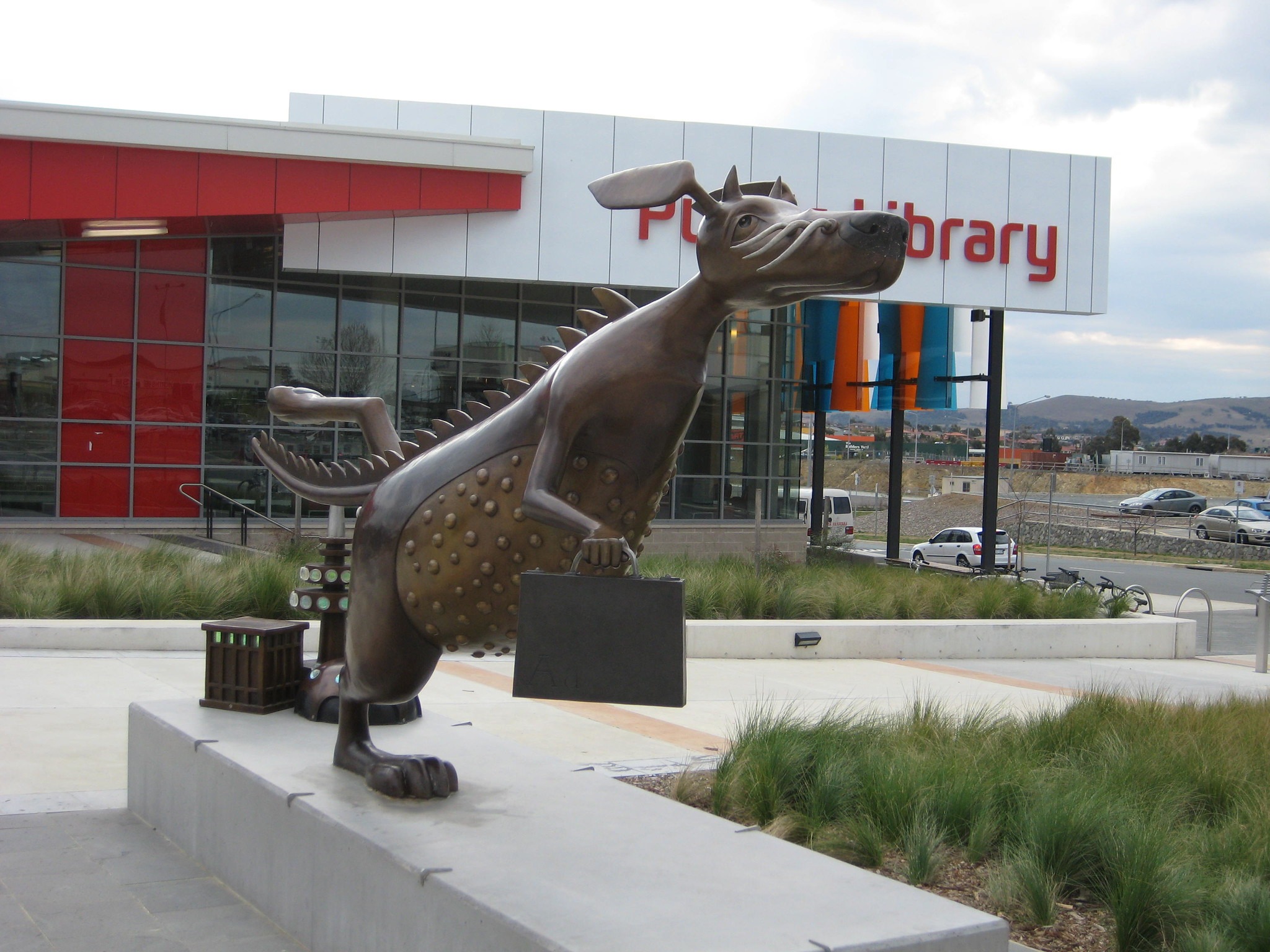
Statue of Alexander Bunyip outside a library (Picture Credit: ArchivesACT)
And more than just entertaining children, the bunyip has also become a spokesperson for environmental messages. The Monster that Ate Canberra, for instance, features a bunyip that eats Canberra only because his billabong is being polluted by the smoggy city. A large, green creature, Bazza the Bunyip, was introduced in the 1990s to talk to kids about littering, sustainable fishing practices, recycling, and swimming safely, with his signature catchphrase, “Don’t muck up the Murray!” (Australia’s largest river). The purple Alexander Bunyip asks children to help his “endangered [animal] friends” find their way home through dangers like “swamp draining” and “bush fires.”
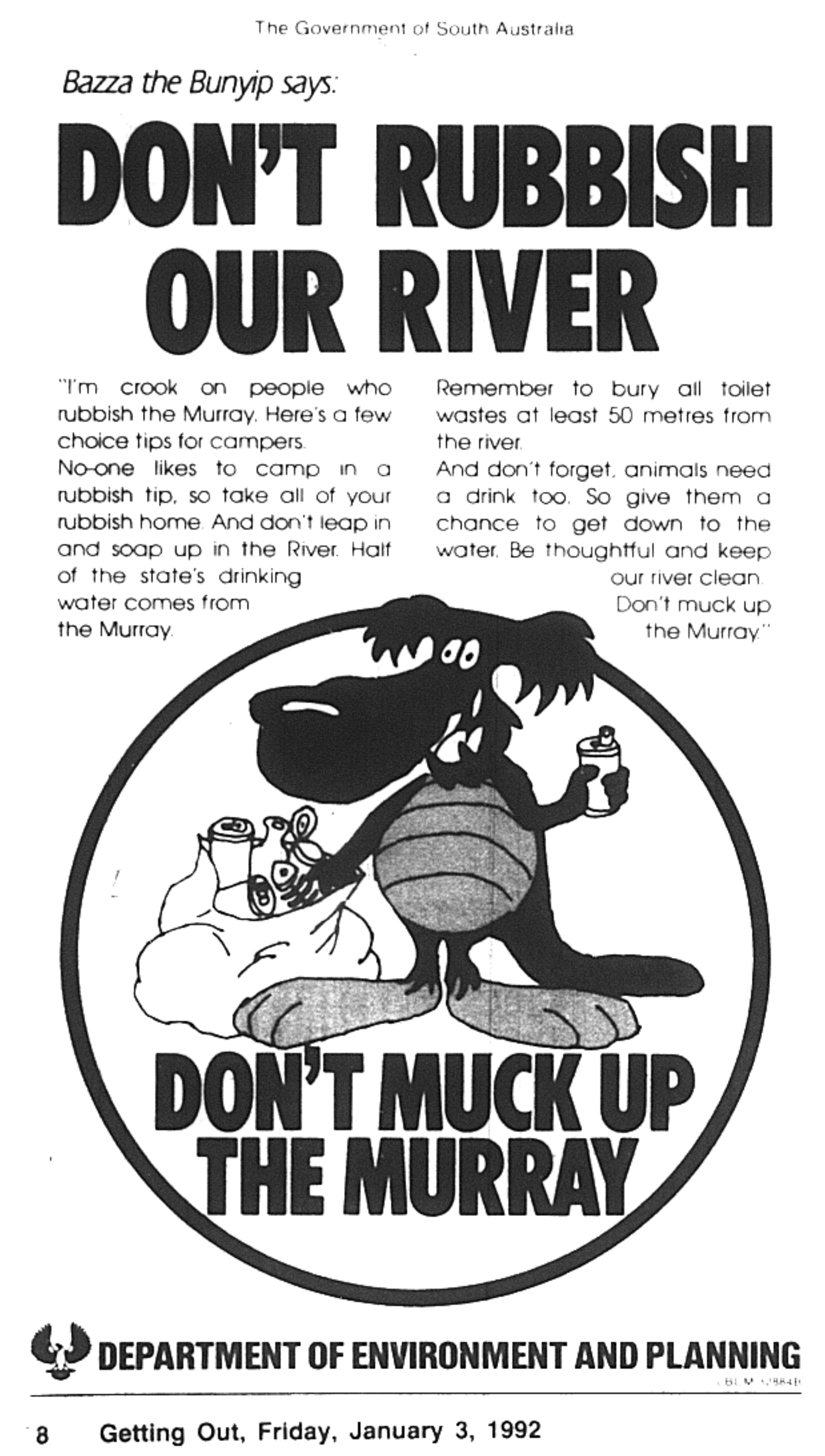
The bunyip’s journey – from fearsome monster, to bogeyman, to friendly cartoon character, to conservation mascot – is a metaphor for our changing relationship with nature. Humans began by fearing nature – we were at the mercy of the elements and often fell prey to other animals. In time, we came to understand nature, tame it, bend it to our will. When humans conquered the planet and emerged as the world’s apex predator, we no longer needed to fear nature; it was wildlife that needed to start fearing us. Now, we are more in danger of destroying nature than being destroyed by it, such that the more forward-thinking among us tell us to hold back, to take stock and conserve the natural environment. As we continue to fell trees, drain billabongs, and pollute rivers, it’s worth noting that the bunyip is no longer the biggest monster in the Outback – we are.

